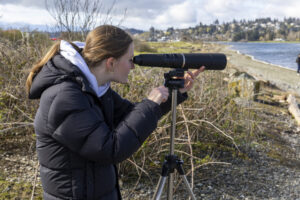After a two-year hiatus, Camosun College’s Environmental Technology (ENVR) program, a science-based diploma that prepares students to develop technologies for tackling the climate crisis and strengthening sustainability, is back, with some changes.
The program has been shortened to two years from three, shaving eight courses off the diploma requirements. Students can still obtain a diploma or choose to transfer to UVic or Royal Roads.
“It’s better for students to kind of come in, get it done, and minimize costs as much as possible and work right away,” says Camosun Environmental Technology chair Emrys Prussin. “You can go to Royal Roads or finish your degree up at UVic; there are a lot of transfer credits in Geography so you can kind of streamline yourself in the Geography degree.”

One of the biggest changes is the Indigenization component.
“We’re offering IST-142, which is the Land, Water, and Stewardship course, and will be offered in winter of 2025,” says Prussin. “Then for each of our courses, we’ve committed to Indigenizing the ENVR-coded courses. We’re going to try to incorporate an Indigenous component where we work with elders who are willing to share knowledge. My hope is that we can find data sets, environmental and scientific data sets, around environmental issues that really impact Indigenous populations.”
The program has been redesigned to align with what industry leaders need the most in an environmental consultant. The courses have been modernized to include technical skills, field study, and materials. The program is one of three within the lower mainland and Vancouver Island that offer Canadian Aquatic Biomonitoring Information Network training. It also provides students with an accreditation upon graduation, which will be needed in the future to provide environmental advice within Canada.
“When students finish our program, they become eligible to fast-track to become a registered biology technologist,” says Prussin. “There is new legislation coming about… You have to be either… a registered professional biologist or a registered professional environmental tech, and each of those accreditations have a scope of work they’re allowed to do.”
Students in the program do field work at a 160-acre property on Barrow Road in Metchosin that Camosun holds the land title for. It provides exclusive space for Camosun students to perform field work in the area of forestry.
“I’m hoping we can do some drone work, such as aerial mapping for forestry application,” he says. “There are a lot of technical skills. Like, we’re going to do soils, but we’re going to take more time and draw soils out longer, so it’s not rushed.”
Calculus was removed from the curriculum, but STAT-216 was added in the first year in order to prepare students for their capstone project. Research methodologies and field sampling techniques, which will expand a student’s ability to apply learned techniques to real-world problems, were added.
“We will also be doing a course where you analyze and interpret data,” says Prussin, “and then in the final year, you do a capstone project where you create a field project where you go and make a field experimental design and collect the data, do the statistics, and then you write a report and do a presentation.”
